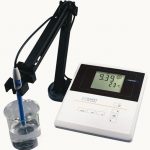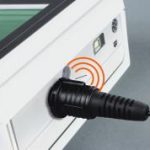In chemical and pharmaceutical production plants, pH measurement is employed for process control and regulation as well as for quality assessment of raw materials and products. The Lab 870 pH meter with automatic sensor recognition provides reliable measurement results and allows a comprehensive documentation of the measuring procedure.
Helmut Becker
In chemical and pharmaceutical manufacturing processes, very high demands are made as to the accuracy, reproducibility and, in particular, the reliability of pH measurements. In many cases maximum yield may only be achievable by maintaining the process within a narrow pH range or stringent legal requirements such as a specific pH limit must be met. In addition operators are obliged to maintain increasingly comprehensive documentation of the complete measuring process.
In addition to growing demands for reliability and documentation of measurements the operator is also confronted with an ever increasing variety of applications. In the end, there is no pH measurement like another pH measurement, and the specific requirements of each sample matrix must be addressed individually. Only a measurement system with matched components, i.e. sensors and instruments optimally suited to the respective application and a correct calibration (in particular the buffer solutions) is capable of meeting challenging measurement requirements.
Wide application spectrum
Schott Instruments’s electrode programme includes several hundred sensors. A second component of the measuring system are the special buffer solutions in glass ampoules. The buffers according to DIN/NIST (DIN 19266) as well as the technical buffers (according to DIN 19267) provide high accuracy and reliability. The buffer solutions are sterilized with superheated steam and hermetically sealed by fusing them in glass ampoules. This means that the buffers are stable for extremely long time-spans without the need for any preservatives to be added. With the Lab family of pH meters, Schott Instruments has closed the pH measurement chain by creating instruments that are perfectly matched to the other links. The accuracy of any measurement depends primarily on the calibration of the sensor. Up to now, the reliability of calibrations has been improved by details such as the automatic buffer recognition. Although useful, this could not guarantee that the electrode plugged in the meter was indeed the electrode whose calibration data were stored in the instrument. Only a new calibration could sofar assure that the zero point and slope of the electrode corresponded to the data stored in the instrument and used for pH calculation.
Wireless communication
The Lab 870 pH meter can automatically recognize and check the connected electrodes. The electrodes featuring a sensor recognition send their data wireless to the metering instrument, thereby assuring that the correct calibration is used for whichever electrode at any time. Thus, mismeasurements are excluded.
The reliability of measurement ist further supported by the CalClock. The CalClock combines a display of the sensor evaluation with a count down clock to remind the operator when calibration is due. Thus, he is always informed of the current status of the sensor being used. Additionally, the Lab 870 features an advanced measuring algorithm specially adapted to Schott Instruments electrodes and providing a shorter calibration and pH measuring time.
The Lab 870 incorporates an RS 232 as well as a USB interface for data transmission, facilitating fast and reliable documentation. For users in the pharmaceutical and food industry it will be interesting to know that the new instruments do not fall in CFR 21, Part 11, as no metered values are being stored. With its smooth, readily disinfectable keyboard and display surfaces, the Lab 870 fulfils all requirements of hygiene sensitive environments. The instrument can also be used under clean room conditions.
cpp 437
Directly to Schott
More about Analytica
Virtual chemistry library
Share:








